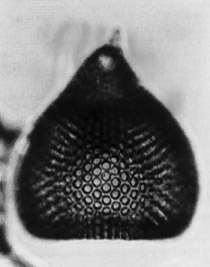 Theocotylissa
ficus (Ehrenberg)
Theocotylissa
ficus (Ehrenberg) Theocotylissa
ficus (Ehrenberg)
Theocotylissa
ficus (Ehrenberg)Eucyrtidium ficus Ehrenberg 1873, p.228; 1875, pl.11, fig.19
Theocotylissa ficus (Ehrenberg), Sanfilippo and Riedel, 1982, p.180, pl.2, figs.19-20 (with synonymy)
Thick shell, subovate to broadly conical in overall form. Cephalis subspherical, with few or no pores, bearing bladed or conical horn of about same length or shorter. Thick shell wall obscures collar stricture, and through it cephalic pores pass obliquely in such a way that the shell material between them projects as supplementary cephalic thorns. Thorax conical, with small circular pores. Lumbar stricture indistinct externally (and completely lost both internally and externally in some late specimens). Abdomen large, inflated (sometimes with straight sides), with circular pores arranged quincuncially in apparent longitudinal rows, and with somewhat constricted, greatly thickened peristome (Sanfilippo and Riedel, 1982).
Maximum length (excluding horn) 155-250 µm, of thorax 35-45 µm, of abdomen 120-195 µm. Maximum breadth 140-235 µm (Sanfilippo et al., 1985).
T. ficus is distinguished from T. alpha by the lack of feet, from T. fimbria by being thicker-walled and having a smooth apertural rim, and from Theocotyle venezuelensis by not having a marked lumbar change in contour externally (Sanfilippo et al., 1985).
The subspherical cephalis, sometimes obscured by the thick shell wall, bears a short conical horn often associated with a cluster of minute thorns. The collar and lumbar strictures are vaguely expressed externally in some specimens, in others not at all. Early forms are ovate in general form and have a thick smooth rim that becomes less prominent and turned inward in later forms. With time, the conical thorax becomes smaller, and the inflated abdomen becomes truncate conical, sometimes with straight sides. The abdominal circular to subcircular pores are arranged quincuncially and show vertical alignment (Sanfilippo et al., 1985).
Theocotylissa ficus occurs in late early and middle Eocene samples from tropical to northern mid-latitudes. Its evolutionary transition from Theocotylissa alpha lies within the Buryella clinata Zone. Its morphotypic last appearance lies within the Podocyrtis chalara Zone.
Theocotylissa ficus is the last member of the lineage leading from Theocotylissa auctor through T. alpha.
Additional illustrations can be found in Foreman, 1973, pl.4, figs.16-20.